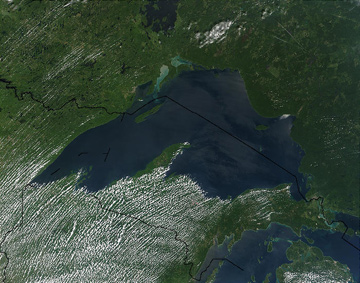Lake Superior may hit record low levels this fall
Lake Superior may hit record low levels this fall
NOAA
August 18, 2007
NOAA hydrologists indicate that Lake Superior is nearing record lows for the month of August, a trend that if continued could break past record lows for the months of September and October. NOAA’s Great Lakes Environmental Research Laboratory is able to forecast lake levels 12 months in advance using current hydrological conditions combined with NOAA’s long-term climate outlooks.
“Lake Superior is less than six centimeters higher than its August record low of 182.97 meters which was set in 1926, and it looks as though the water levels may continue to plunge,” said Cynthia Sellinger, deputy director of NOAA’s Great Lakes Environmental Research Laboratory in Ann Arbor, Mich. “NOAA’s lake level forecasts predict that there is a 15 to 20 percent probability that new monthly records will be set sometime this fall.”
 Clouds stream across parts of Minnesota, Wisconsin and Michigan on the southern borders of Lake Superior while the Canadian province of Ontario appears to be enjoying a clear summer afternoon. Image taken by the Moderate Resolution Imaging Spectroradiometer (MODIS) on the Terra satellite on August 14, 2003. |
As of today, the level of Lake Superior was 183.028 meters. The record low level for September is 183.06 meters set in 1926. That is also the record low level for October, which was set in 1864. Records date back to 1860.
Lake Superior, with a surface area of 31,700 square miles, is second in area only to the Caspian Sea, and is greater than the combined areas of Vermont, Massachusetts, Rhode Island, Connecticut, and New Hampshire. For every inch Lake Superior drops, 529 billion gallons of water are displaced. In the past decade, 12.7 trillion gallons of water have left Lake Superior.
The lake has been decreasing by a rate of 10 mm every year since 1978, and has dropped a dramatic two feet during the last decade. The Great Lakes region has been experiencing warmer winters since 1997, and the combination of warmer air temperatures and less ice cover leads to increased evaporation rates during the winter. Also, with less snow pack, there is less spring runoff to replenish the lakes.